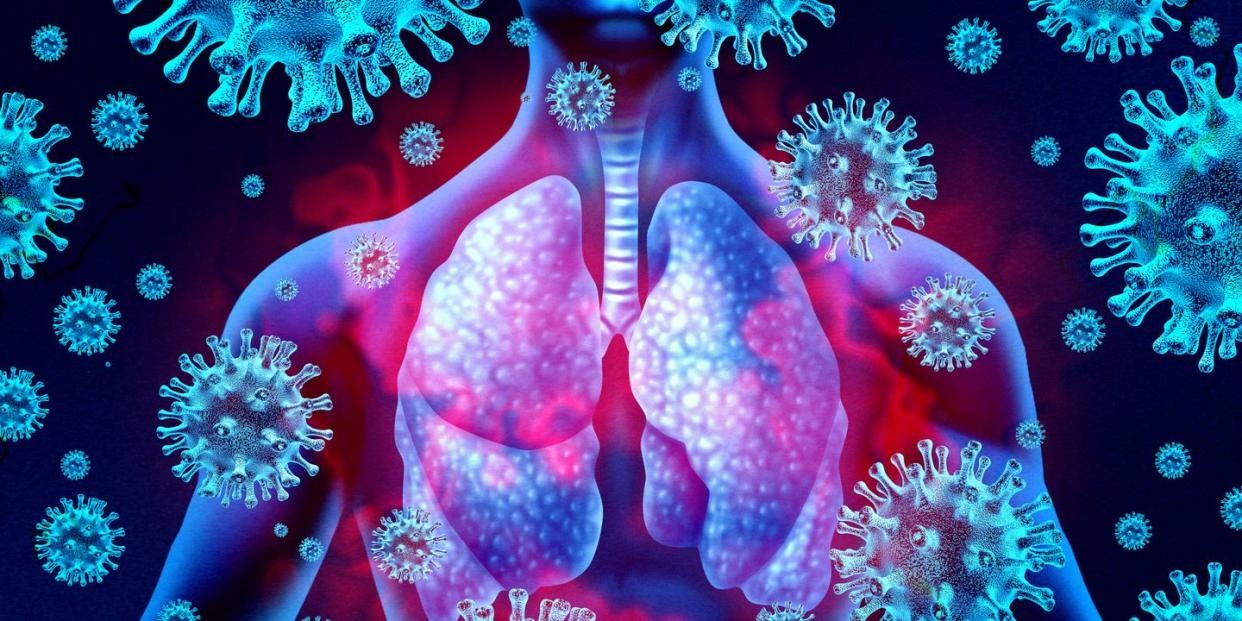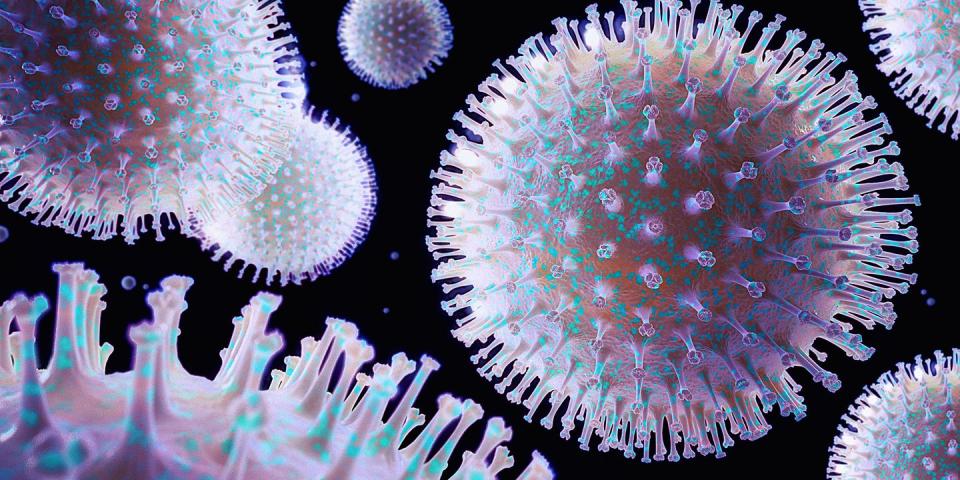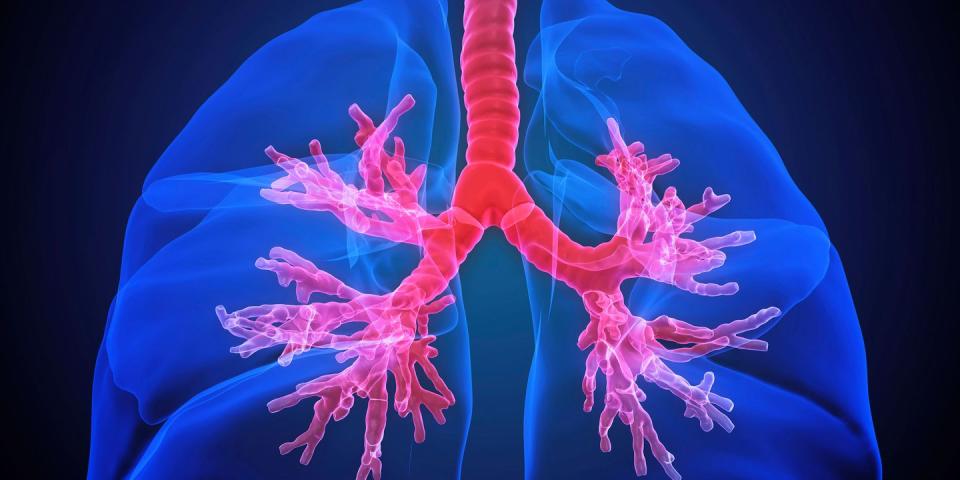Here’s what COVID-19 actually does to your body

The number of confirmed COVID-19 cases has now surpassed 600,000 globally. Thankfully, the vast majority of these cases are mild. However, there have been almost 30,000 deaths attributed to this novel coronavirus.
The virus, to use its full title, Severe Acute Respiratory Syndrome Coronavirus 2 (SARS-CoV-2), causes respiratory illness. Symptoms range from a mild cough to acute pneumonia. COVID-19 affects the lungs, like the viruses SARS and MERS, but it can also have devastating effects on the rest of the body.
Much remains undiscovered about the virus, but experts are learning about how the virus enters the body, and what happens if you become infected.
To find out more, we spoke to Dr Greg Maguire, Fulbright-Fogarty Fellow at the National Institutes of Health, and author of Thinking and Eating For Two: The Science of Using Systems 1 and 2 Thinking to Nourish Self and Symbionts.
How does coronavirus enter the body?
Coronavirus can enter the body in several ways. In common to other respiratory viruses, the primary manner is through inhalation. If an infected person coughs or sneezes, the virus particles can remain in the air for some time in tiny droplets. When you breathe in through the mouth or nose, the virus enters your body.
Another less common way is through the eyes, nose, or mouth if you touch your face with contaminated hands.
The virus causes harm at the site where it enters the body. For many people, this means a stuffy or runny nose. With luck, your immune system can tackle the virus before it makes its way further into the respiratory system. If not, it passes into the lungs.
How your immune system responds
When any pathogen invades your body, your immune system jumps into action. The coronavirus looks like a sphere covered in spikes. Those spikes are surface proteins, and they are the reason why the virus can successfully invade the cells in your respiratory tract.
The cells in your lungs, arteries, heart, kidneys, and intestines have a protein on their surface called angiotensin-converting enzyme 2 (ACE2). Once the virus binds to these proteins, it uses them as a gateway into your cells.
‘Once the virus enters the body, it enters our cells through a two-step process. In the first stage, the spike proteins on the virus bind to ACE2 receptors located on host cells,’ explains Dr Maguire.
During the second stage of the process, the virus hijacks a special enzyme called a protease that speeds up the breakdown of protein. There are lots of different proteases, but the one that SARS-CoV-2 targets is called TMPRRS2.
Dr Maguire goes on to explain that ‘the spike proteins on the virus must also bind to a protease on the host cells, thought to include the protease TMPRRS2. Once this happens, the protease cleaves the spike protein on the virus in two places, allowing the virus to fuse with the host cell and deposit its RNA into the cells.’ Once it’s inside a cell, it can cause real damage.
RNA is viral genetic material. The virus uses the mechanisms inside your cell to replicate its RNA and make copies of itself. The process destroys cells and creates thousands of new viral particles that infect other cells in the respiratory tract.
Types of immunity
You have three types of immunity called passive, innate, and adaptive. Passive immunity is borrowed from another source, such as breast milk from mothers. It doesn’t play much of a part in immunity from COVID-19 for most of us.
The innate immune system includes skin, mucous membranes, and a generalised, initial immune cell response that your body uses to combat general invaders. It’s not as powerful as adaptive immunity.
Adaptive immunity is like a library of immune cells. As you go through life, you continually encounter pathogens, including viruses, bacteria, fungi, and parasites. These microorganisms can cause disease. Your immune system builds a fighting force of specialised cells called antibodies that remember each pathogen.
Because SARS-CoV-2 is an entirely new or novel virus, your immune system doesn’t recognise it, and you don’t have an adaptive response at first.

How the virus hijacks your cells
To be healthy, you need the antibodies and adaptive immune response to do their work. However, sometimes the immune system causes collateral damage in your body with an exaggerated response. It can produce more significant problems than the original pathogenic invader.
Immune cells produce proteins called cytokines to help them coordinate the battle against coronavirus. If the levels of cytokines are too high, they can trigger an extreme inflammatory reaction called a cytokine storm.
When the immune system suddenly deposits a vast amount of cytokines into the lungs, your body begins to attack healthy cells as well as the infected, and there is carnage. It’s the equivalent of using a rocket launcher instead of a pistol.
Cytokine storms cause inflammation that leads to ruptured blood vessels that leak blood. It can affect the entire circulatory system. Cytokine storms can cause immense damage, multiple organ failure, sepsis, and even death.
What does coronavirus do to your lungs?
For the majority of infected people, the lungs are where most of the action takes place. When the infection reaches and irritates the air passages, you develop a cough and fever.
In the first few days following infection, coronavirus rapidly invades the lung cells that make mucous, surfactant, and the cilia covered cells. Your lungs use cilia, which are hair-like structures, to disperse mucus and clean the lungs.
You might find mucus disgusting, but it has two essential purposes. It protects the respiratory system from pathogens and stops them from drying out. Specialised cells called pneumocytes make surfactant, which is a lubricant for the lungs that helps oxygen pass into the blood.
Dr. Dimitar Marinov, Assistant Professor at the Department of Hygiene and Epidemiology, Medical University of Varna, Bulgaria, explains that ‘upon entering through ACE2, SARS-CoV-2 affects the type-2-pneumocytes that make surfactant.’
Dr Marinov continues that ‘the role of surfactant is to prevent the collapse of the lungs by keeping the tiniest of air sacs (alveoli) open. Surfactant reduces fluid accumulation in the lungs and keeps the airways dry’.
Current thinking is that COVID-19 causes issues in common with SARS. The SARS virus killed cilia cells. Patients had lungs filled with cellular debris and fluid. Many COVID patients develop pneumonia and suffer shortness of breath when the virus travels deep down into the lungs.
Once the virus reaches the lower parts of the lungs, the immune system realises that there are serious problems. It steps up its game to fight the virus, inundating the lungs with immune cells, and potentially summoning an extreme immune reaction.
The immune overreaction causes further debris to flood the lungs, and pneumonia becomes more serious. While this is happening, the inflammation also causes the lungs to fill with fluid. The blood doesn’t receive enough oxygen, due to the lack of surfactant. Lung impairment increases, and some patients suffer respiratory failure, which can lead to death.
Can COVID-19 permanently damage your lungs?
Even if the patient avoids death, the overactive immune response could permanently damage their lungs. Evidence from Wuhan, China shows that patients showed lung lesions or holes and had ‘ground-glass opacity.’
The lungs are scarred, inflexible, and can’t provide enough oxygen transfer for the patient to breathe without the use of a ventilator.
The World Health Organization report that 13.8% of patients with COVID-19 have severe disease.

The stomach and digestive system
Experts are still not clear about coronavirus and gastrointestinal involvement. Some patients have reported nausea and diarrhoea, but these cases are much less frequent than respiratory symptoms.
There are now reports of faecal or stool samples testing positive for the virus, which further highlights the need for regular and thorough hand washing.
It seems that coronavirus enters the body directly through the respiratory system, but that we should consider other routes of entry. Some viruses are particular about the cells they invade. With COVID-19, it infiltrates the body and looks for the gateway ACE2 receptor. If it finds a compatible receptor, it invades.
The heart and circulatory system
COVID-19 can affect the heart and vascular system. Physicians find that some patients have low blood pressure, irregular heart rhythm, or ischaemia, which is when the tissues don’t get enough blood passing through them. In a cytokine storm, the entire vascular system suffers, as blood leaks from blood vessels.
What experts know is that those who have a preexisting cardiovascular condition are at higher risk of developing severe disease. When the lungs are suffering, the heart is under more pressure.
The liver and kidneys
COVID-19 can cause renal damage. However, the doctors were not sure if the virus or the drugs used to treat the patient caused the issues. Some COVID-19 patients need to have kidney transplants.
Thankfully, renal injury is rare, but when it occurs, it is usually fatal. During the SARS epidemic, 91.7% of patients with acute renal impairment died.
Researchers don’t yet fully understand the involvement of the kidneys, but the damage could be due to lower levels of circulating oxygen that happens with pneumonia.
The good news
COVID-19 is a scary infection, and you should respect expert advice about safeguarding your health. Thankfully the majority of infected people, around 80%, have mild to moderate disease, which can last up to around two to three weeks.
Last updated: 31-03-2020
You Might Also Like

 Yahoo News
Yahoo News 
